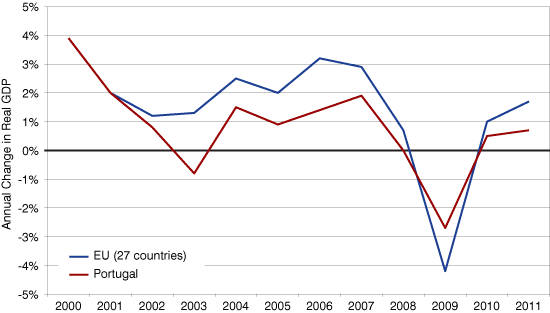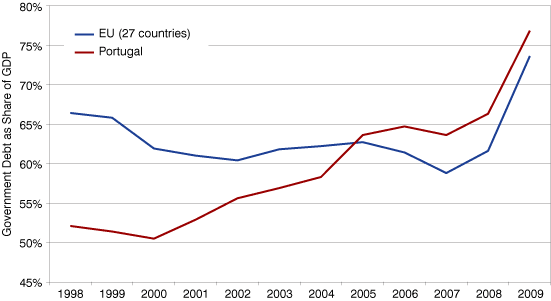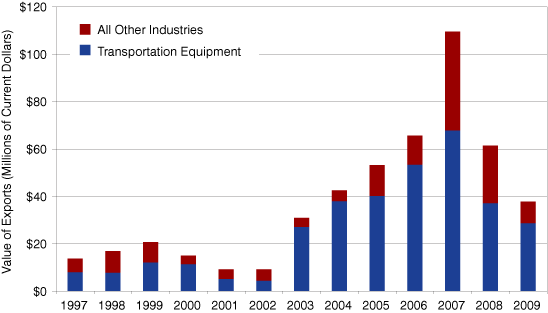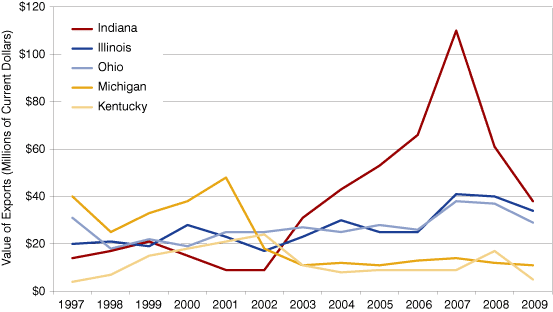Countries IN Profile: Portugal
Located on the westernmost edge of the Iberian Peninsula, Portugal is a country of 10.6 million people, covering an area of just over 55,200 square miles, slightly larger than the state of New York. The country currently has an annual population growth rate of 0.1 percent, significantly below the current U.S. rate of 0.9 percent.1 Compared to the majority of Western Europe and the developed world, Portugal generally ranks as one of the less advanced countries, appearing in 34th place on the UN Human Development Index (HDI), the 17th lowest score from the EU-27.2 While Portugal is a highly developed state according to the UN definition, it is still significantly behind the United States on a number of the HDI measures (see Table 1). Despite the economic growth facilitated by EU membership, Portugal’s GDP per capita remains approximately 48 percent below the Euro area average, a situation unlikely to improve given the recent economic developments.
Table 1: UN Human Development Index (HDI), 2007
| HDI Measures | Portugal | United States |
|---|---|---|
| HDI Value | 0.909 | 0.956 |
| Life Expectancy at Birth (Years) | 78.6 | 79.1 |
| Adult Literacy Rate (Percent Ages 15 and Above) | 94.9% | N/A |
| Combined Gross Enrollment Ratio* | 88.8% | 92.4% |
| GDP per capita (PPP US Dollars) | $22,765 | $45,592 |
*The proportion of people eligible for education who are receiving it, combined across primary, secondary and tertiary education.
Source: Human Development Reports
Despite these economic difficulties, Portugal’s relationship with the state of Indiana has remained strong, with Portuguese industries purchasing almost $38 million worth of Indiana products in 2009, primarily in the transportation equipment industry. This figure may only account for 0.2 percent of all Indiana’s exports, but Portugal continues to have a noticeable impact in the state’s economy.
The Portuguese Economy
A bloodless coup in 1974, colloquially referred to as the “Revolution of the Carnations” removed the authoritarian government from power. In 1986 Portugal joined the European Community alongside its neighbor, Spain.3
Throughout the late 1990s Portugal sustained a remarkable period of continued economic growth, consistently surpassing the average GDP growth rate for other European Union member states. Furthermore, Portugal managed to couple this growth with fiscal stability and well-managed public finances, making it one of the few signatory states to meet the Maastricht Treaty requirements for participation in the creation of the EU common currency. Portugal positioned itself well to experience the benefits of economic union, establishing a comparatively open and integrated economy with a low inflation rate throughout the positive upswing of the European business cycle during the second half of the 1990s.
The relationship with the European Union, however, has had a downside. The following decade has seen a marked fluctuation in Portugal’s progress, with the country falling into recession in 2003, recovering in 2004, before the global recession once again returned the country to negative growth in 2008. Current forecasts suggest that the recovery will be slow and gradual. The European Commission predicts only 0.5 percent growth in Portugal’s GDP for 2010 followed by an equally unimpressive 0.75 percent growth in 2011 (see Figure 1).4 The Organisation for Economic Co-operation and Development (OECD), in contrast, is more optimistic, projecting an average growth of 0.8 percent for 2010 and 2.1 percent for 2011. That said, both organizations anticipate further increases in unemployment through the next two years. The government response to this situation has been to increase public spending and directly support employment. This may have mitigated the effects of the recent market collapse, but it has also drastically increased public borrowing from an average 65 percent of GDP prior to the recession to 77 percent in 2009 (see Figure 2) and borrowing is currently predicted to further increase to 86 percent in 2010.5 As a result, Portugal’s credit rating has been severely downgraded.6
Figure 1: Annual Change in Real GDP, 2000 to 2011*

*2010 and 2011 are projections
Source: IBRC, using Eurostat data
Figure 2: Government Debt as a Share of GDP, 1999 to 2009

Source: IBRC, using Eurostat data
Organizations such a Goldman Sachs have begun to group Portugal with Ireland, Italy, Greece and Spain as the EU15 countries suffering the most during the recession, referring to the group by the acronym “PIIGS.” Yet there is some dispute as to the usefulness of this term given that the five states have had such different economic problems over the past few years. Recently, Barclay’s bank forbade its employees from using the acronym because it suggests these states are in some way different or separate from the rest of the European economy. There are concerns that grouping these five countries together will undermine confidence in their economies.7 The European Central Bank (ECB) together with the International Monetary Fund (IMF), has constructed a package of loans, primarily to assist the Greek government but also to aid any other vulnerable European states if required. Portugal is considered the European state most likely to require assistance after Greece; so far, it has not needed to call upon the assistance of these emergency funds. However, despite these measures to restore investor confidence, the ECB is still concerned that there remains the potential for further losses by European banks later this year if economic growth is weaker than expected.8
Falling tax revenues and mounting debt have caused the national government to reduce public investment, but structural funding from the EU has continued. EU funds support Portugal’s 2007-2013 strategy for economic growth, competiveness and employment. The country’s research, development and innovation capabilities are the main targets for these funds. Other areas expecting significant investment include workforce training, the ICT infrastructure and high-speed transport links. All these expenditures will develop Portugal to a standard comparable to the rest of Western Europe and increase the country’s prospects as a destination for foreign direct investment.9
Portuguese industry has made notable investment in the Midwest with two major projects in the field of sustainable energy production. Horizon Wind, a Houston-based subsidiary of Energias de Portugal (EDP) has begun the construction of two wind farm facilities, one outside Bloomington, Ill., and one in Indiana’s Benton and White counties. If all the planned stages of the Indiana development are completed, it will be the largest facility the company operates in the United States. EDP expects to spend more than $1.3 billion within the United States over the next three years in order to fund these projects.10
Trade
Despite the downturn in GDP and domestic spending, the value of Indiana’s exports to Portugal has not suffered as much as might be expected, declining to just below 2004 levels in 2009 and forecast to return to growth in 2010 and 2011 (see Figure 3). In 2009, Indiana’s largest export to the global market was vehicles, closely followed by electrical machinery and industrial machinery.
Figure 3: Value of Indiana's Exports to Portugal, Transportation Equipment and All Other Sectors, 1997 to 2009

Source: IBRC, using Eurostat data
The value of Portugal’s exports to the United States has been declining since 2006, falling 54 percent in the last four years. At the same time, American exports to Portugal rose until 2008, then fell by 41 percent in 2009. These dramatic changes are the result of collapsing demand. The fall in the demand for foreign goods in the United States occurred before Portugal because the recession hit the United States sooner. As the economic turmoil spread, domestic demand in Europe began to experience a similar decline.
Imports to Indiana from Portugal remained relatively low compared to other Western European countries. In 2009, Indiana ranked ninth amongst all states in exports to Portugal, but this position will likely slip in 2010 as the demand for transportation equipment continues to sag. Regionally speaking, however, Wisconsin is the only Midwestern state that has surpassed Indiana in the value of its exports and none of the states that border Indiana currently exports a greater value of goods to Portugal.
In many respects, Portugal and Indiana’s imports and exports are mirror images. The largest industrial sector exporting from Indiana to Portugal is transportation equipment manufacturing, accounting for 70 percent of all exports in the past 12 years (refer again to Figure 3). Noticeably, production increased rapidly from $4.7 million in 2002 to $41.8 million in 2007; an increase of almost 900 percent. No bordering state has been able to duplicate this rapid expansion in the value of exports to Portugal, suggesting Indiana has a particularly strong relationship with the country compared to other states in the region (see Figure 4). Simultaneously, in Portugal, the commodity most exported to the world market is non-railway vehicles. The value of that commodity follows the same pattern of expansion and contraction as Indiana’s exports of transportation equipment, growing during the period 2002 to 2007 (from $3.7 million to $6.4 million), followed by two years of decline in 2008 and 2009.
Figure 4: Annual Value of Exports to Portugal, Indiana and Neighboring States, 1997 to 2009

Source: IBRC, using WISERtrade data
The quantity of vehicles exported by Portugal influences the quantity of transportation equipment the country imports from Indiana. Consequently, an expansion in Portugal’s export market will likely produce a resulting expansion within Indiana’s manufacturing sector. The European Commission is currently predicting that Portugal’s economic recovery will be largely fueled by its export sales due to demand in the depressed domestic market.11 Therefore, one would expect that an export-led economic recovery in Portugal would be accompanied by an expansion in Indiana’s production and exports of transportation equipment.
Conclusion
It is remarkable how quickly Portugal’s fortunes have changed over the past 15 years— from exceeding EU growth averages throughout the second half of the 1990s to record levels of government debt, negative growth and unemployment in the following decade. While this economic downturn is not solely the fault of the Portuguese national economy, it demonstrates the risks inherent in economic integration. The prognosis is somewhat optimistic, with the economy set to expand and employment to rise at least over the next two years. Perhaps during this next decade Portugal will recreate its former success.
While Indiana may purchase relatively little from Portugal, the country is an important destination for the state’s exports. Furthermore, Portuguese investment is set to become a major player in the electricity industry in the Midwest. Because it is relatively small, Portugal may not attract the media attention of Germany or the United Kingdom, but one should not overlook the important connections between the Hoosier and Portuguese economies.
Notes
- World Bank, “Population Growth, Annual %,” https://data.worldbank.org/indicator/SP.POP.GROW/countries/latest?display=default(accessed June 1, 2010).
- The EU-27 consists of Austria, Belgium, Bulgaria, Cyprus, the Czech Republic, Denmark, Estonia, Finland, France, Germany, Greece, Hungary, Ireland, Italy, Latvia, Lithuania, Luxemburg, Malta, the Netherlands, Poland, Portugal, Romania, Slovakia, Slovenia, Spain, Sweden and the United Kingdom.
- Prior to the Treaty of Maastricht in 1993, the European Union was known as the European Community. BBC, “Portugal Country Profile,” March 9, 2010, http://news.bbc.co.uk/2/hi/europe/country_profiles/994099.stm (accessed June 3, 2010).
- Directorate General for Economic and Financial Affairs, European Economic Forecast (Brussels: European Commission, 2010).
- Directorate General for Economic and Financial Affairs, European Economic Forecast (Brussels: European Commission, 2010).
- BBC, “Portugal Credit Rating Downgraded Over Debt Concerns,” March 24, 2010, http://news.bbc.co.uk/2/hi/8584812.stm (accessed June 3, 2010).
- "PIIGS Label Too Ham-Fisted for Barclay's," The Irish Times, February 6, 2010, Business Today section.
- European Central Bank, "Financial Stability Review-Overview" (June 2010): 16.
- Directorate General for Regional Policy, Portugal: Results of the Negotiations of Cohesion Policy and Strategies and Programmes 2007-2013 (Brussels: European Commission, 2007).
- Jeffery Ryser, "Horizon Wind Says Texas Market Overbuilt," Electric Utility Week (July 13, 2009): 20.
- Directorate General for Economic and Financial Affairs, European Economic Forecast (Brussels: European Commission, 2010).
Matthew Hutchinson
Research Assistant, Indiana Business Research Center, Indiana University Kelley School of Business
